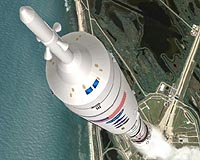|
|
|
NASA Sets Target Date For Ares I-X Rocket's Test Launch Cape Canaveral FL (SPX) Sep 23, 2009  NASA is targeting Tuesday, Oct. 27, for the flight test of the Ares I-X rocket, pending successful testing and data verification. Senior managers made the decision after a meeting Monday at NASA Headquarters in Washington. The Oct. 27 target date has been confirmed with the Air Force's Eastern Range. The launch window will extend from 8 a.m. to noon EDT. There is another launch opportunity ... read more
NASA is targeting Tuesday, Oct. 27, for the flight test of the Ares I-X rocket, pending successful testing and data verification. Senior managers made the decision after a meeting Monday at NASA Headquarters in Washington. The Oct. 27 target date has been confirmed with the Air Force's Eastern Range. The launch window will extend from 8 a.m. to noon EDT. There is another launch opportunity ... read moreProton Launch Delayed Due To Problem With Glonass Satellite  Moscow, Russia (RIA Novosti) Sep 23, 2009
Moscow, Russia (RIA Novosti) Sep 23, 2009Russia's launch of a Proton-M carrier rocket from the Baikonur space center has been delayed due to a problem with one of Glonass-M satellites, a source at the launch facility in Kazakhstan said Tuesday. The source said that the decision to delay the launch from Friday until a later date was "made not at the space center but in Moscow, at [Russian Space Agency] Roscosmos." ... more |
G20 billionaires could end world poverty in one year's earnings: Oxfam
Australia set to cede COP31 hosting rights to Turkey COP30 dragged into clash over gender language Brazil's Lula hunts for deal at Amazon climate summit EU states back new delay to anti-deforestation rules Lula lands in Amazon to press for climate deal To combat climate anxiety, COP negotiator recommends meditation Nations 'still far' from deal at UN climate talks: France Nearly a third of women face partner or sexual violence: WHO Belgian climate case pits farmer against TotalEnergies
|
|
| Previous Issues | Sep 22 | Sep 21 | Sep 20 | Sep 17 | Sep 16 |
| . |
Phobos Grunt Including Phobos LIFE Delayed Until 2011 Pasadena CA (SPX) Sep 23, 2009
Pasadena CA (SPX) Sep 23, 2009The Russian space agency, Roscosmos, has decided to delay from 2009 to 2011 the launch of the Phobos Grunt mission to study and return samples from the Martian moon Phobos. The Planetary Society's LIFE (Living Interplanetary Flight Experiment) experiment, designed to test the ability of microorganisms to survive deep space flight, is part of the mission. Due to the relative orbits of ... more Oceansat-2 Set For Launch Tomorrow From Sriharikota  Chennai, India (PTI) Sep 23, 2009
Chennai, India (PTI) Sep 23, 2009Oceansat-2 satellite that would help identify potential fishing zones and provide inputs for weather forecasting is poised to be launched into orbit on board the Polar Launch Satellite Vehicle from the spaceport of Sriharikota in the east coast, 90 kms from here, Wednesday. Riding piggyback on the 970 kg Oceansat-2, six other nano satellites - four from Germany and one each from ... more Looking For Life As We Don't Know It  Potsdam, Germany (SPX) Sep 23, 2009
Potsdam, Germany (SPX) Sep 23, 2009Scientists at a new interdisciplinary research group in Austria are working to uncover how life might evolve with "exotic" biochemistry and solvents, such as sulfuric acid instead of water. Their research will be presented at the European Planetary Science Congress in Potsdam by Johannes Leitner. The University of Vienna established a research group for Alternative Solvents as a Basis for ... more |
. |
| . |
Argon On The Moon Sydney, Australia (SPX) Sep 23, 2009
Sydney, Australia (SPX) Sep 23, 2009In early October, NASA's LCROSS mission will impact a crater near the Moon's south pole, creating a massive plume of debris that will be visible from Earth. Telescopes on the ground, and on board the LCROSS shepherd spacecraft, will search this plume for evidence of water vapour. The main goal of this mission is to provide evidence of ice deposits in the Moon's polar regions, which are ... more School Kids Track LCROSS  Huntsville AL (SPX) Sep 22, 2009
Huntsville AL (SPX) Sep 22, 2009Using a colossal radio telescope in the Mojave Desert, school kids around the world are helping NASA track the LCROSS spacecraft as it heads for a crash landing on the Moon. On Oct. 9th, LCROSS will smash into the inky-dark shadows of a crater near the Moon's south pole in search of water. Eager youngsters are locked on to LCROSS's signal as intently as they've ever viewed a video game ... more Astronomy Question Of The Week: How Quickly Is The Universe Expanding  Bonn, Germany (SPX) Sep 23, 2009
Bonn, Germany (SPX) Sep 23, 2009In the 1920s, Edwin Powell Hubble was analysing the distances between Earth and various galaxies using the Mount Wilson Observatory in California. In the process, he measured the electromagnetic radiation of the galaxies and discovered mostly what are known as 'redshifts' in their spectra; that is, in the distributions of the various wavelengths. The Doppler effect, among other things, is ... more |
. |
| Previous Issues | Sep 22 | Sep 21 | Sep 20 | Sep 17 | Sep 16 |
| The contents herein, unless otherwise known to be public domain, are Copyright 1995-2009 - SpaceDaily. AFP and UPI Wire Stories are copyright Agence France-Presse and United Press International. ESA Portal Reports are copyright European Space Agency. All NASA sourced material is public domain. Additional copyrights may apply in whole or part to other bona fide parties. Advertising does not imply endorsement, agreement or approval of any opinions, statements or information provided by SpaceDaily on any web page published or hosted by SpaceDaily. Privacy statement |